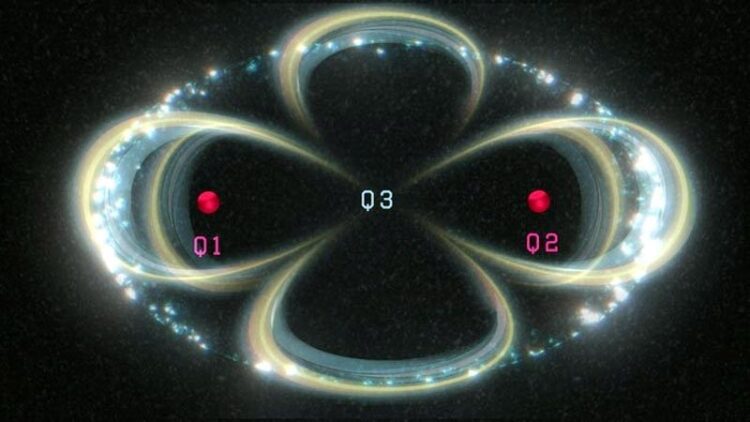Probing the inner workings of high-fidelity quantum processors

A silicon quantum processor in which an electron spin qubit (blue) enables communication between two phosphorus nuclear spin qubits (red). Researchers used gate set tomography to show that the processor’s logic gates surpass 99 percent fidelity.
Image courtesy of Sandia National Laboratories and UNSW Sydney
Scientists use gate set tomography to discover and validate a silicon qubit breakthrough.
The Science
Tiny quantum computing processors built from silicon have finally surpassed 99 percent fidelity in certain logic operations (“gates”). Quantum computers store information in the quantum state of a physical system (in this case, two silicon qubits) then manipulate the quantum state to perform a calculation in a manner that isn’t possible on a classical computer. Fidelity is a measure of how close the final quantum state of the real-life qubits is to the ideal case. If the fidelity of logic gates is too low, calculations will fail because errors will accumulate faster than they can be corrected. The threshold for fault-tolerant quantum computing is over 99 percent. Three research groups demonstrated more than 99 percent fidelity for “if-then” logic gates between two silicon qubits. This required precisely measuring failure rates, identifying the nature and cause of the errors, and fine-tuning the devices. The researchers used a technique called gate set tomography to achieve this in two of the three experiments. The technique combined the results of many separate experiments to create a detailed snapshot of the errors in each logic gate. The researchers were able to make a precise determination of the error generated by different sources and fine-tune the gates to achieve error rates below 1 percent.
The Impact
Quantum computing may be able to solve certain problems, such as predicting the behavior of new molecules, far faster than today’s computers. To do so, researchers must build qubits, engineer precise couplings between them, and scale up systems to thousands or millions of qubits. Researchers expect qubits made of silicon to scale up better than the qubits used in today’s testbed quantum computers, which rely on either trapped ions or superconducting circuits. Achieving high-fidelity logic gates opens the door to silicon-based testbed quantum computers. It also demonstrates the power of detailed error characterization to help users pinpoint error modes then work around or eliminate them.
Summary
Qubits – protected, controllable 2-state quantum systems – lie at the heart of quantum computing. Quantum computing processors are built by assembling an array of at least two (and hopefully someday thousands or millions) of qubits, with an integrated control system that can perform logic gates on each qubit and between pairs of qubits. Their performance and capability are limited by errors in the logic gates. High-fidelity gates have low error rates. Once the error rate is less than a certain threshold – which scientists believe to be about 1 percent – quantum error correction can, in principle, reduce it even further. Beating this threshold in laboratory experiments is a major milestone for any qubit technology.
What kinds of errors are occurring is also a big deal for quantum error correction. Some errors are easier to eliminate or correct; others may be fatal. Quantum computing researchers from the Department of Energy (DOE)-funded Quantum Performance Laboratory worked with Australian experimental physicists to design a new kind of gate set tomography customized to a 3-qubit silicon qubit processor. They used it to measure the rates of 240 distinct types of possible errors on each of six logic gates. Of those possible errors, 95 percent did not occur in the experiments, and the remaining errors added up to less than 1 percent infidelity. Research groups in Japan and the Netherlands reported similar results simultaneously, with the Dutch group also using the DOE-funded pyGSTi gate set tomography software to confirm their demonstration.
Funding
Sandia’s portion of this collaborative work was funded by several sources. These include the Department of Energy Office of Science, Office of Advanced Scientific Computing Research’s (ASCR) Quantum Testbed Pathfinder program, ASCR Early Career Research program, and National Quantum Information Science Research Centers (Quantum Systems Accelerator).
Journal: Nature
DOI: 10.1038/s41586-021-04292-7
Method of Research: Experimental study
Subject of Research: Not applicable
Article Title: Precision tomography of a three-qubit donor quantum processor in silicon
Article Publication Date: 19-Jan-2022
Media Contact
Michael Church
DOE/US Department of Energy
michael.church@science.doe.gov
Office: 2028416299
All latest news from the category: Information Technology
Here you can find a summary of innovations in the fields of information and data processing and up-to-date developments on IT equipment and hardware.
This area covers topics such as IT services, IT architectures, IT management and telecommunications.
Newest articles

Innovative 3D printed scaffolds offer new hope for bone healing
Researchers at the Institute for Bioengineering of Catalonia have developed novel 3D printed PLA-CaP scaffolds that promote blood vessel formation, ensuring better healing and regeneration of bone tissue. Bone is…

The surprising role of gut infection in Alzheimer’s disease
ASU- and Banner Alzheimer’s Institute-led study implicates link between a common virus and the disease, which travels from the gut to the brain and may be a target for antiviral…

Molecular gardening: New enzymes discovered for protein modification pruning
How deubiquitinases USP53 and USP54 cleave long polyubiquitin chains and how the former is linked to liver disease in children. Deubiquitinases (DUBs) are enzymes used by cells to trim protein…



